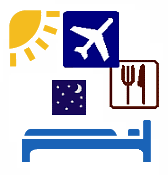いま、1型糖尿病は
2007年11月14日
| 29 Time Difference and Insulin Injection Dosage |
 Nowadays, people travel abroad quite easily.
Nowadays, people travel abroad quite easily.
I had a female patient with type 1 diabetes visiting our outpatient clinic yesterday. She has just returned from a homestay in Canada. Though she had been to Guam prior to this trip, this was her first homestay experience. She came back safely and encountered no problems during the trip.
Before she left Japan, she had various concerns. Contrary to her worries, she did not have any problems at X-ray inspections at airports. She brought with her an English medical certificate just in case, but she came back without having to present it to anyone during the trip. Her HbA1c after the trip was around 7.0%.
I have written about concerns diabetic patients may have when going abroad in the last couple of articles. In this article, I would like to touch on time difference and insulin injection dosage though I assume those of you who are used to traveling abroad have your own ways to deal with them.
If you are often pointed out by your doctor about less favorable glucose control, I recommend you consult well with your doctor before going abroad.
I would like to mainly talk about adjustment of insulin dosage during flights to and from the destination.
In the case of one injection a day
The schoolbook explanation usually talks about how to adjust insulin dosage when traveling west and when traveling east. This method may apply to those injecting NPH insulin once a day.
In fact, however, those of you injecting NPH, or 10R or 20R once per day do no have to think too seriously. In most cases, you could simply inject it in the morning while in Japan and do the same in the morning once you arrive at the destination.
Even if you inject it as you do while in Japan, you are less likely to develop hypoglycemia. You will hardly have poorer glucose control during flights either.
This is because you tend to not move much and to eat more than usual while on a plane.
In the case of four injections per day
Then, what about those on four-time injections per day? It is even simpler.
You just need to inject regular or rapid-acting insulin per meal during flights and inject intermediate or long-acting soluble insulin at bedtime as usual while in overseas.
You could determine pre-meal insulin dosage based on the amount of carbohydrate to be consumed as usual and inject the same usual dosage of intermediate or long-acting insulin at bedtime.
During flights, you eat meals and do not move much, so you tend to take in more calories than you need. Thus, you will hardly develop hypoglycemia. You would rather likely to have hyperglycemia.
Also, since the air inside a plane is dry leading to rather dehydration, blood becomes concentrated, which is likely to cause hyperglycemia.
Use in-flight service wisely
In order to avoid "economic-class syndrome," let's make sure to take enough water. These days, cabin attendants often give you 500ml-water in plastic bottle shortly after meals.
You will also find fruits and so forth in the galley (where cabin attendants are) near lavatory. If you get hungry, you can ask cabin attendants to bring you what you want to eat or drink. You do not need to hesitate at all.
What about insulin dosage after arriving at the destination?
As I wrote in 27 Meals While in Other Countries and Insulin Dosage, you could start with the same dosage as you inject while in Japan if you are in Southeast Asia where carbohydrate intake is high.
<
If you are in the U.S. or in Europe where the diet is low in carbohydrate and high in protein and fat, you could start with smaller insulin dosage.
I have written about this topic also in the vol.27 of "Novo Care Friend". "Insulin wa tomodachi (Insulin is our friend)" edited by the Japan Association for Diabetes Education and Care (published by Ishiyaku Publishers Inc. in 2000) covers 1-week overseas trip of a patient with juvenile-onset type 1 diabetes, which I hope you will find useful.
©2007 Yasuko Uchigata
時差とインスリン注射量
 最近は、海外にほんとうにみなさん手軽にでかけます。
最近は、海外にほんとうにみなさん手軽にでかけます。昨日(2007年9月)もカナダにはじめてホームステイした1型糖尿病女性が外来に来られました(グアムに足慣らしででかけたことがありましたが)。まったく問題なく、帰国されました。
出国するときは、なんだかんだと心配されていましたが、X線チェックにもなにもひっかからず、一応英文証明書を持って行かれましたが、だれに提示することもなく帰国されました。
帰国後の血糖コントロールもHbA1c 7.0%くらいでした。
海外旅行の際のご心配なことについて、前回、前々回も書きましたが、時差とインスリン注射量について、海外に何回もでかけられた方は自分なりにやり方を開拓していらっしゃることと思いますが、最後に少し述べてみたいと思います。
血糖コントロールがあまり良くないね、と主治医の先生からたびたびいわれている方は、先生によくご相談して、海外にでかけてください。
ここでは、行き帰りのインスリン注射量の調整をどうしようかということについて、述べてみます。
でもかえって、NPHインスリンや10Rや20Rインスリン注射1回の方は、あまりむずかしく考えることなく、日本にいるときの朝、向こうに着いた朝にいつものように注射して、まず問題ないようです。
かの地でいつものように注射していても低血糖の心配は少なく、行き帰りをこのように雑に行なっても血糖コントロール悪化させることはまずないでしょう。
なぜなら、飛行機に乗っているときは、活動量が少なく相対的に食事量がいつもより多くなる傾向があるからです。
機内でも食事ごとに速効型ないし超速効型注射をし、向こうに着いてから寝る前などにいつものように中間型ないし持効型溶解インスリンを注射するだけです。
食事前のインスリン注射は、これまで通り、炭水化物量を見て注射量を決める、寝る前の中間型ないし持効型溶解インスリンの量はこれまで通りです。
また、機内は乾燥していますので、どちらかといえば脱水の方向に傾きやすいので、濃縮してさらに高血糖になりやすいというわけです。
また、お腹がすくようでしたら、トイレのそばのギャレー(スチュワーデスさんがいるところ)に果物などがいつも置いてあります。また、スチュワーデスさんを呼べば希望する食べるものや飲むものを持ってきてくれます。 遠慮はまったく要りません。
アメリカや欧州など炭水化物が少なく、たんぱく質や脂肪が多い地域ではインスリン量を減らして始めるといいでしょう。
この内容については、以前ノボケアフレンド27号にも書きました。また、(社)日本糖尿病協会編「インスリンはともだち」(医歯薬出版、2000年)にも、若年1型糖尿病の方の海外旅行の1週間が掲載されています。参考になさってください。
※ヘモグロビンA1c(HbA1c)等の表記は記事の公開時期の値を表示しています。
Copyright ©1996-2024 soshinsha. 掲載記事・図表の無断転用を禁じます。
治療や療養についてかかりつけの医師や医療スタッフにご相談ください。

 医療・健康情報グループ検索
医療・健康情報グループ検索